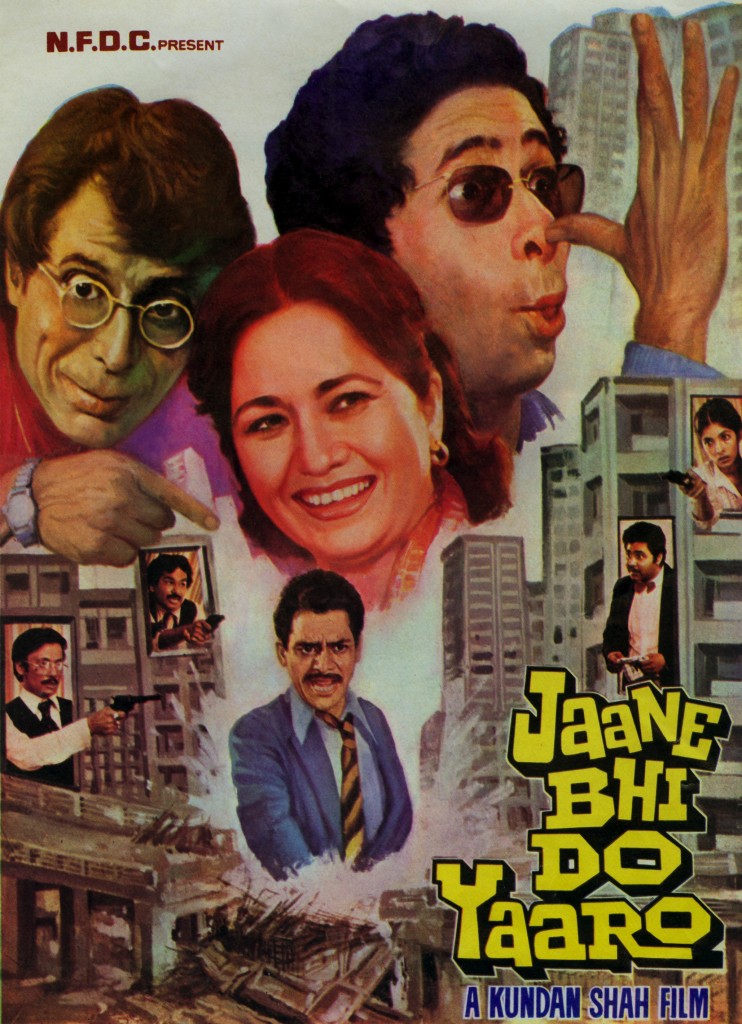Two bumbling photographers, Vinod Chopra (Naseeruddin Shah) and Sudhir Mishra (Ravi Baswani), are employed by Shobha (Bhakti Bharve), the editor of a scandal sheet, Khabardaar. They have to spy on millionaire property developer, Tarneja (Pankaj Kapoor), and Muncipal commissioner, D’Mello (Satish Shah). The photographers uncover dirty business between Tarneja and his equally unsavoury rival, Ahuja (Om Puri). Inadvertently, they stumble upon the murder of the commissioner and capture it on film but in spite of repeated blow ups of the photograph are unable to identify the killer. The commissioner is, in fact, killed by Tarneja who as a result wins the contract to build the flyover that collapses shortly after. The photographers get hold of D’Mello’s corpse to prove he was murdered but they lose the corpse, which leads to an extended chase where everybody chases everybody and everybody chases the corpse. Finally, Tarneja, Ahuja and Shobha all strike a deal amidst themselves and the two photographers are framed for the collapse of the flyover.
Jaane Bhi Do Yaaro is without a doubt amongst the greatest comedies ever made on the Indian screen. The film is outrageously funny and remarkable for its freshness and spontaneity and holds up well even today. Director Kundan Shah casts a satirical eye on civic admistration, the police, the press and the corporate world. By combining slapstick humour with farce and verbal wit, he comes up with a film that is delightfully irrelevant as it lampoons practically every institution.
The film makes use of various direct and indirect references in its digs. The collapse of the flyover shown in a TV news clip in the film is, in fact, footage of the actual Byculla bridge which collapsed shortly before the film was made. Tarneja and Ahuja are a composite of Bombay’s biggest builder, Raheja, while Shobha, the editor of Khabardaar, is an allusion to Shobha De, former editor of a film gossip magazine. The film is also full of in-joke references. The two photographers are named after Shah’s filmmaking colleagues and the code word Albert Pinto of the two sleuths refers to Saeed Akhtar Mirza’s film of the same name. Large posters of Kumar Shahani’s Maya Darpan (1972) and Mani Kaul’s Uski Roti (1969) can be seen pasted on the walls during the chase. The park wherein the photographers take click the photograph of D’Mello’s killing and blow up the picture repeatedly is called Antonioni Park since the sequence was obviously inspired from Antonioni’s Blow Up.
Almost every sequence and gag stands out brilliantly by itself – whether it is the cake throwing sequence or a totally drunk Om Puri encountering D’Mello in his coffin and thinking his car has broken down, he tows him around! But the highlight of the film is without doubt the chase of the missing corpse, which is a sizeable part of the film and provides the film with some of its most inventive and humorous moments. The entire sequence of the Mahabharata being enacted on stage with the corpse as Draupadi is a scream!
The acting too is uniformly marvelous and lifts the film even more with each of the actors spot on with their comic timings. But Satish Shah’s deadpan performance as the corpse still takes the cake. Special mention must also be made of the late Ravi Baswani and especially Om Puri, who shows a wonderful and then unexplored range of comic timing.The film is also aided tremendously by Renu Saluja’s razor-sharp editing. The film was a favourite of hers and one she found extremely challenging to edit.
After all the humor, the film finally ends on a more realistic and pessimistic note. Shah justifies it by explaining, “The end is symbolic…I am trying to say that the system has put the common man into jail. In the kind of set-up which encourages corruption, he suffers the most.”
It is a pity that after such a promising beginning, Kundan Shah’s subsequent films made within the mainstream Hindi film Industry, while having their moments, are nowhere near the innovative level of Jaane Bhi Do Yaaro which remains his best and freshest film by far. As Naseeruddin Shah said in a recent interview that if anything, the issues the film looks at have magnified today and are more relevant than ever before.
Simply put, a masterpiece. No two ways about it.
Hindi, Comedy, Color
https://www.youtube.com/watch?v=SDClKXKn0l8


